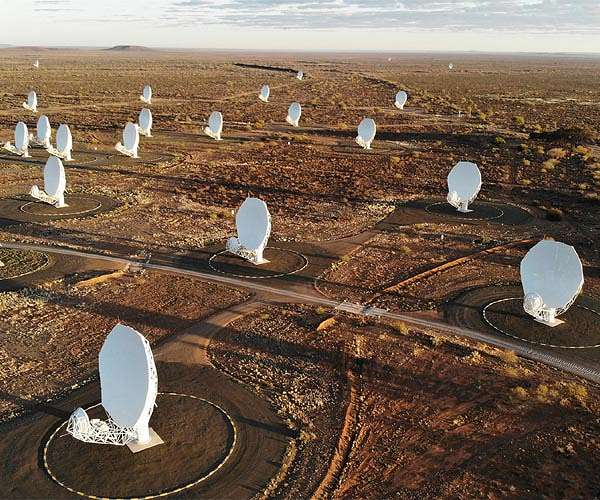
Southern hemisphere’s biggest radio telescope begins search for ET signatures (Image Credit: Space Daily)
Breakthrough Listen has begun observations using a powerful new instrument deployed to the MeerKAT radio telescope in the remote Karoo region of South Africa. The new search for technosignatures – indicators of technology developed by extraterrestrial intelligence – expands the number of targets searched by a factor of 1,000.
The astronomers and engineers on the Breakthrough Listen team have spent the last three years developing and installing the most powerful digital instrumentation ever deployed in the search for technosignatures, and integrating the equipment with the MeerKAT control and monitoring systems in cooperation with SARAO engineers. The new hardware complements Listen’s ongoing searches using the Green Bank Telescope in the USA, the Parkes Telescope in Australia, and other telescopes around the world. But while Listen’s programs at the GBT and Parkes involve moving these thousand-ton-plus dishes to point at targets all over the sky, the program on MeerKAT usually won’t mechanically move the antennas.
“MeerKAT consists of 64 dishes, which can see an area of the sky 50 times bigger than the GBT can view at once,” explained Breakthrough Listen Principal Investigator Dr. Andrew Siemion. “Such a large field of view typically contains many stars that are interesting technosignature targets. Our new supercomputer enables us to combine signals from the 64 dishes to get high resolution scans of these targets with excellent sensitivity, all without impacting the research of other astronomers who are using the array.”
By operating in this “commensal” mode, Breakthrough Listen gains access to one of the world’s most capable and sensitive radio telescopes almost 24 hours a day, 7 days a week. The ability to scan 64 targets at a time within the main field of view also improves Listen’s ability to reject interfering signals from human technology such as Earth-orbiting satellites. The Listen team had to develop sophisticated targeting and scheduling software to ensure the survey goals could be met in the desired timeframe 1. They have also developed an automated data processing pipeline that scans through the data in near-real-time to search for interesting signals.
Breakthrough Listen is also working with SARAO to develop research opportunities for astronomers and data processing experts in Africa on this cutting-edge program. The search for life in the Universe has become a major focus area for research internationally, and the Breakthrough Initiatives are leaders in the field.
“I am very excited to be able to conduct a search for technosignatures using one of the most sensitive telescopes in the world,” remarked Dr. Cherry Ng, Breakthrough Listen’s Project Scientist for MeerKAT. “It will take us just two years to search over one million nearby stars. MeerKAT will provide us with the ability to detect a transmitter akin to Earth’s brightest radio beacons out to a distance of 250 light years in our routine observing mode.”
Dr. Fernando Camilo, Chief Scientist for SARAO, the observatory that built and operates MeerKAT, is also excited about the new search.
“MeerKAT has a remarkable combination of sensitivity and survey speed, which makes it a wonderful telescope for SETI,” said Camilo. “The telescope was planned and developed here in South Africa, and it’s very exciting that young South Africans will have the chance to be involved at the forefront of the search for life beyond Earth.”
“One of the first targets we’ll be observing is our nearest neighbor star, Proxima Centauri, which appears to host two small rocky planets in the star’s habitable zone,” said Breakthrough Initiatives Executive Director, Dr. S. Pete Worden. “Routine observations with the Listen backend on MeerKAT are now underway, and the team looks forward to sharing the first science results in the coming months.”
Related Links
South African Radio Astronomy Observatory
Breakthrough Initiatives
Lands Beyond Beyond – extra solar planets – news and science
Life Beyond Earth
|
|
Tweet |
|
|
|
We need your help. The SpaceDaily news network continues to grow but revenues have never been harder to maintain. With the rise of Ad Blockers, and Facebook – our traditional revenue sources via quality network advertising continues to decline. And unlike so many other news sites, we don’t have a paywall – with those annoying usernames and passwords. Our news coverage takes time and effort to publish 365 days a year. If you find our news sites informative and useful then please consider becoming a regular supporter or for now make a one off contribution. |
||
|
SpaceDaily Monthly Supporter $5+ Billed Monthly |
SpaceDaily Contributor $5 Billed Once credit card or paypal |
|
Do you speak extra-terrestrial?
St Andrews, Scotland (SPX) Nov 03, 2022
What does humanity do when we discover we are not alone in the cosmos? A new international research hub at the University of St Andrews will coordinate global expertise to prepare humanity for such an event and how we should respond.
While we might never learn about the existence of life beyond Earth, or even about another intelligent civilisation, there’s a chance it could be detected sooner rather than later. But are we prepared?
The new SETI Post-Detection Hub, hosted by the Centre for Ex … read more









